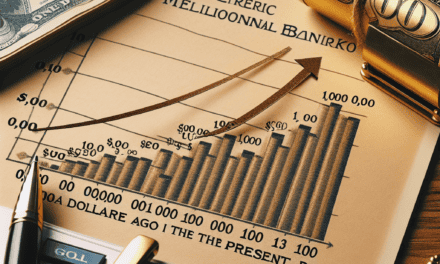“Stability Holds: Dollar Steady as Markets Eye Inflation Data and Fed Insights”
Introduction
The dollar maintained a steady position in global currency markets as investors awaited key U.S. inflation data and remarks from Federal Reserve officials. This stability reflects market participants’ cautious approach, balancing expectations of potential monetary policy shifts with economic indicators. The upcoming inflation report is anticipated to provide insights into the pace of price increases, influencing the Fed’s future interest rate decisions. Meanwhile, comments from Fed officials are closely monitored for any signals regarding the central bank’s stance on inflation and economic growth. This period of anticipation underscores the dollar’s role as a barometer for economic sentiment and policy direction.
Impact Of US Inflation Data On The Dollar’s Stability
The stability of the US dollar is a subject of considerable interest to economists, investors, and policymakers alike, particularly as it stands firm ahead of the release of crucial US inflation data and anticipated remarks from the Federal Reserve. The dollar’s steadiness in the face of these impending events underscores its resilience and the complex interplay of factors that influence its value. As market participants await the latest inflation figures, the potential impact on the dollar’s stability remains a focal point of analysis.
Inflation data is a critical economic indicator that provides insights into the purchasing power of consumers and the overall health of the economy. When inflation rises, it can erode the value of money, leading to higher prices for goods and services. Conversely, low inflation can signal weak demand and economic stagnation. Therefore, the release of inflation data is closely monitored as it can significantly influence monetary policy decisions by the Federal Reserve. The Fed’s response to inflationary pressures, whether through interest rate adjustments or other monetary tools, can have profound implications for the dollar’s value.
In anticipation of the upcoming inflation data, the dollar has maintained a steady position, reflecting a cautious optimism among investors. This stability suggests that market participants are confident in the Fed’s ability to manage inflationary pressures without causing undue volatility in the currency markets. However, the actual inflation figures could either reinforce this confidence or prompt a reevaluation of the dollar’s trajectory. Should the data indicate a higher-than-expected rise in inflation, it may lead to speculation about more aggressive monetary tightening by the Fed, potentially boosting the dollar as interest rates rise.
Moreover, the Federal Reserve’s remarks following the release of inflation data will be scrutinized for any hints regarding future monetary policy. The Fed’s communication strategy plays a crucial role in shaping market expectations and can either bolster or undermine the dollar’s stability. Clear and consistent messaging from the Fed can help anchor expectations and prevent erratic market movements. Conversely, any perceived ambiguity or inconsistency in the Fed’s statements could introduce uncertainty, affecting the dollar’s performance.
In addition to domestic factors, the dollar’s stability is also influenced by global economic conditions. As the world’s primary reserve currency, the dollar is sensitive to international developments, including geopolitical tensions, trade dynamics, and economic performance in other major economies. These external factors can either amplify or mitigate the impact of US inflation data on the dollar. For instance, if other major economies are experiencing similar inflationary pressures, the relative attractiveness of the dollar may remain unchanged, preserving its stability.
In conclusion, the dollar’s steadiness ahead of US inflation data and Federal Reserve remarks highlights the intricate balance of factors that determine its value. While the upcoming inflation figures and Fed communications are pivotal, the dollar’s stability is also contingent on broader economic and geopolitical contexts. As such, market participants will continue to closely monitor these developments, assessing their implications for the dollar’s future trajectory. Ultimately, the interplay between domestic economic indicators and global influences will shape the dollar’s path in the coming months, underscoring the complexity of currency markets in an interconnected world.
Federal Reserve’s Remarks: Implications For The Dollar
The dollar has maintained a steady position in the global currency markets as investors keenly await the release of the latest U.S. inflation data and remarks from the Federal Reserve. These events are pivotal, as they hold significant implications for the future trajectory of the dollar. The Federal Reserve’s comments, in particular, are closely scrutinized by market participants, as they provide insights into the central bank’s monetary policy stance and its potential impact on the currency’s value.
In recent months, the dollar has experienced fluctuations driven by varying economic indicators and geopolitical developments. However, the anticipation surrounding the upcoming inflation data and Federal Reserve remarks has brought a sense of stability to the currency. Investors are eager to understand how these factors will influence the Federal Reserve’s approach to interest rates, which in turn affects the dollar’s strength.
The Federal Reserve’s role in shaping monetary policy is crucial, as it directly impacts the dollar’s value. When the central bank signals a tightening of monetary policy, such as raising interest rates, it often leads to a stronger dollar. This is because higher interest rates tend to attract foreign investment, increasing demand for the currency. Conversely, a dovish stance, characterized by lower interest rates or quantitative easing, can weaken the dollar as it reduces the currency’s appeal to investors.
As the Federal Reserve prepares to deliver its remarks, market participants are particularly interested in any indications of a shift in policy. The central bank has been navigating a complex economic landscape, balancing the need to control inflation with the desire to support economic growth. Inflation data plays a critical role in this decision-making process, as it provides a measure of price stability and economic health. A higher-than-expected inflation rate could prompt the Federal Reserve to adopt a more hawkish stance, potentially leading to a stronger dollar.
Moreover, the global economic environment adds another layer of complexity to the Federal Reserve’s decision-making process. With other major economies also grappling with inflationary pressures and varying recovery trajectories, the Federal Reserve’s actions can have far-reaching implications. A stronger dollar can impact global trade dynamics, as it affects the competitiveness of U.S. exports and the cost of imports. Therefore, the central bank’s remarks are not only significant for domestic markets but also for international economic relations.
In addition to inflation data, the Federal Reserve’s assessment of the labor market and overall economic conditions will be closely monitored. A robust labor market and strong economic growth could provide the central bank with the confidence to pursue a more aggressive monetary policy, further influencing the dollar’s value. Conversely, signs of economic weakness or labor market challenges may lead to a more cautious approach, potentially tempering the dollar’s strength.
In conclusion, the dollar’s steadiness ahead of the U.S. inflation data and Federal Reserve remarks underscores the importance of these events in shaping market expectations. As investors await clarity on the central bank’s policy direction, the implications for the dollar remain significant. The Federal Reserve’s remarks will not only provide insights into its monetary policy stance but also influence the broader economic landscape, affecting both domestic and international markets. As such, the upcoming developments are poised to play a crucial role in determining the dollar’s future trajectory.
Analyzing The Dollar’s Performance Amid Inflation Concerns
The dollar’s performance in the global currency markets has been a focal point for investors and analysts alike, particularly as the United States grapples with persistent inflation concerns. As the world awaits the latest US inflation data and remarks from the Federal Reserve, the dollar has shown remarkable steadiness, reflecting a complex interplay of economic indicators and market expectations. This stability, however, is not merely a result of domestic factors but also a response to global economic dynamics.
To begin with, the anticipation surrounding the US inflation data is palpable, as it is expected to provide crucial insights into the trajectory of consumer prices. Inflation has been a persistent issue, with supply chain disruptions and labor market challenges contributing to rising costs. The Federal Reserve’s response to these inflationary pressures is of paramount importance, as it will influence monetary policy decisions that directly impact the dollar’s value. Market participants are keenly observing whether the Fed will maintain its current stance or signal a shift towards more aggressive measures to curb inflation.
Moreover, the dollar’s steadiness can be attributed to its status as a safe-haven currency. In times of economic uncertainty, investors often flock to the dollar, seeking stability amidst volatility. This phenomenon has been evident in recent months, as geopolitical tensions and economic uncertainties in other parts of the world have bolstered the dollar’s appeal. Consequently, even as inflation concerns loom large, the dollar has managed to hold its ground, supported by its inherent safe-haven characteristics.
In addition to domestic factors, the global economic landscape plays a significant role in shaping the dollar’s performance. The ongoing recovery from the COVID-19 pandemic has been uneven across different regions, with varying degrees of success in vaccination efforts and economic reopening. This disparity has led to divergent monetary policies among major economies, further influencing currency markets. For instance, while some central banks have begun tightening monetary policy in response to inflation, others remain committed to accommodative measures to support growth. These differing approaches create a complex environment in which the dollar operates, as investors weigh the relative strength of the US economy against its global counterparts.
Furthermore, the Federal Reserve’s communication strategy is crucial in managing market expectations. Fed officials have consistently emphasized their commitment to data-driven decision-making, underscoring the importance of upcoming inflation data in shaping future policy actions. The central bank’s transparency in conveying its policy intentions helps mitigate market volatility, contributing to the dollar’s steadiness. Investors are particularly attentive to any signals regarding the timing and pace of interest rate hikes, as these will have direct implications for the dollar’s trajectory.
In conclusion, the dollar’s steadiness ahead of US inflation data and Federal Reserve remarks is a testament to the intricate balance of domestic and global factors influencing currency markets. While inflation concerns remain a significant challenge, the dollar’s safe-haven status, coupled with the Fed’s strategic communication, has provided a stabilizing effect. As the world continues to navigate the complexities of economic recovery, the dollar’s performance will remain a key barometer of investor sentiment and economic resilience. The forthcoming inflation data and Fed remarks will undoubtedly be pivotal in shaping the dollar’s path forward, as market participants seek clarity on the future direction of US monetary policy.
How Inflation Data Influences Currency Markets
The stability of the US dollar in the face of impending inflation data and Federal Reserve remarks underscores the intricate dynamics of currency markets. As investors and analysts keenly await these economic indicators, understanding how inflation data influences currency markets becomes crucial. Inflation, a measure of the rate at which the general level of prices for goods and services is rising, erodes purchasing power and can significantly impact currency valuation. When inflation is high, the purchasing power of a currency diminishes, leading to potential depreciation. Conversely, low inflation can bolster a currency’s strength, as it suggests stable purchasing power.
In anticipation of inflation data, currency markets often exhibit heightened sensitivity. Traders and investors scrutinize these figures to gauge the economic health of a nation and predict central bank actions. For instance, if inflation data indicates a rising trend, it may prompt the Federal Reserve to consider tightening monetary policy by raising interest rates. Higher interest rates typically attract foreign investment, as they offer better returns on investments denominated in that currency, thereby increasing demand for the dollar and potentially boosting its value.
Moreover, the relationship between inflation data and currency markets is not isolated. It is intertwined with other economic indicators and geopolitical factors. For example, employment data, consumer spending, and global trade dynamics also play pivotal roles in shaping market expectations and reactions. Therefore, while inflation data is a critical component, it is part of a broader economic tapestry that influences currency valuation.
As the US dollar remains steady ahead of the release of inflation data, market participants are also attuned to forthcoming remarks from Federal Reserve officials. The Fed’s communication strategy is a powerful tool in managing market expectations. Through speeches, press conferences, and official statements, the Fed provides insights into its economic outlook and potential policy adjustments. These communications can either reinforce or mitigate the market’s reaction to inflation data, depending on how they align with or diverge from investor expectations.
Furthermore, the global context cannot be overlooked when considering the impact of US inflation data on currency markets. In an interconnected world economy, developments in other major economies, such as the European Union, China, and Japan, can influence the dollar’s performance. For instance, if inflationary pressures are also rising in other regions, it may lead to a synchronized tightening of monetary policies globally, affecting currency valuations across the board.
In conclusion, the steadiness of the US dollar ahead of inflation data and Federal Reserve remarks highlights the complex interplay of economic indicators, central bank policies, and global factors in currency markets. Inflation data serves as a vital barometer for assessing economic conditions and predicting monetary policy actions, which in turn influence currency valuation. As market participants navigate these dynamics, they must consider a multitude of factors, including the Fed’s communication strategy and global economic developments, to make informed decisions. Ultimately, the intricate relationship between inflation data and currency markets underscores the importance of a comprehensive understanding of economic indicators and their broader implications.
The Role Of The Federal Reserve In Dollar Valuation
The valuation of the US dollar is a complex interplay of various economic factors, with the Federal Reserve playing a pivotal role in its fluctuations. As the central bank of the United States, the Federal Reserve, often referred to as the Fed, is tasked with managing the country’s monetary policy, which includes influencing interest rates and controlling the money supply. These actions, in turn, have a significant impact on the value of the dollar in the global market. As investors and analysts keenly await the upcoming US inflation data and remarks from the Federal Reserve, the dollar remains steady, reflecting the market’s anticipation of potential policy shifts.
To understand the Fed’s influence on the dollar, it is essential to consider how interest rates affect currency valuation. When the Federal Reserve raises interest rates, it often leads to an appreciation of the dollar. This is because higher interest rates offer better returns on investments denominated in dollars, attracting foreign capital and increasing demand for the currency. Conversely, when the Fed lowers interest rates, the dollar may depreciate as investors seek higher returns elsewhere. Thus, the Fed’s interest rate decisions are closely monitored by market participants, as they provide critical signals about the future direction of the dollar.
Moreover, the Federal Reserve’s approach to inflation is another crucial factor in dollar valuation. Inflation erodes the purchasing power of a currency, and central banks, including the Fed, aim to maintain price stability by keeping inflation within a target range. When inflation data indicates rising prices, the Fed may respond by tightening monetary policy, which can bolster the dollar. Conversely, if inflation is below target, the Fed might adopt a more accommodative stance, potentially weakening the currency. Therefore, the release of US inflation data is a key event for currency traders, as it offers insights into the Fed’s potential policy adjustments.
In addition to interest rates and inflation, the Federal Reserve’s communication strategy plays a significant role in shaping market expectations and, consequently, the dollar’s value. The Fed’s remarks, whether through official statements, press conferences, or speeches by its members, provide guidance on the central bank’s economic outlook and policy intentions. Clear and consistent communication can help stabilize the dollar by reducing uncertainty and aligning market expectations with the Fed’s objectives. However, any perceived ambiguity or unexpected shifts in tone can lead to volatility, as traders reassess their positions based on new information.
As the market awaits the latest US inflation data and forthcoming remarks from the Federal Reserve, the dollar’s steadiness reflects a cautious optimism among investors. They are poised to interpret these developments as indicators of the Fed’s future policy trajectory. The interplay between inflation data and the Fed’s response will likely influence the dollar’s path in the coming months. In this context, the Federal Reserve’s role in dollar valuation remains as crucial as ever, with its decisions and communications serving as key determinants of currency movements.
In conclusion, the Federal Reserve’s influence on the US dollar is multifaceted, encompassing interest rate decisions, inflation management, and strategic communication. As the central bank navigates the complexities of economic conditions, its actions and statements continue to be pivotal in shaping the dollar’s valuation. With the upcoming US inflation data and Fed remarks on the horizon, market participants remain attentive, ready to adjust their strategies in response to the evolving economic landscape.
Dollar Trends: What To Expect From Upcoming Inflation Reports
The dollar has maintained a steady position in the global currency markets as investors keenly await the release of upcoming U.S. inflation data and remarks from the Federal Reserve. This stability comes amid a backdrop of economic uncertainty and fluctuating market sentiments, which have kept traders and analysts on their toes. The anticipation surrounding these reports is palpable, as they are expected to provide crucial insights into the future trajectory of U.S. monetary policy and its subsequent impact on the dollar.
In recent months, the dollar has experienced a series of fluctuations, driven largely by varying expectations of inflation and interest rate adjustments. As inflationary pressures have mounted, the Federal Reserve has been under increasing scrutiny regarding its policy decisions. The central bank’s approach to managing inflation, particularly in terms of interest rate hikes, is a key factor influencing the dollar’s performance. Consequently, the upcoming inflation data is poised to play a pivotal role in shaping market expectations and guiding the Fed’s policy direction.
The significance of the inflation data cannot be overstated, as it serves as a barometer for the health of the U.S. economy. A higher-than-expected inflation rate could prompt the Federal Reserve to adopt a more aggressive stance on interest rate hikes, which would likely bolster the dollar. Conversely, if the inflation figures come in lower than anticipated, it may lead to a more cautious approach from the Fed, potentially weakening the dollar. Thus, market participants are closely monitoring these developments, as they seek to position themselves strategically in response to the evolving economic landscape.
Adding another layer of complexity to the situation are the forthcoming remarks from Federal Reserve officials. These statements are expected to provide further clarity on the central bank’s outlook and policy intentions. Investors will be listening intently for any hints or signals regarding the timing and magnitude of future interest rate adjustments. The Fed’s communication strategy is crucial in managing market expectations and ensuring stability in the financial markets. Therefore, any deviation from the anticipated narrative could have significant implications for the dollar’s trajectory.
Moreover, the global economic environment continues to exert its influence on the dollar. Geopolitical tensions, trade dynamics, and economic performance in other major economies all contribute to the currency’s movements. As such, the dollar’s steadiness ahead of the U.S. inflation data and Fed remarks reflects a complex interplay of domestic and international factors. Market participants are acutely aware of these dynamics and are factoring them into their analyses and decision-making processes.
In conclusion, the dollar’s current stability is a testament to the cautious optimism prevailing in the markets as investors await critical economic indicators and central bank guidance. The upcoming U.S. inflation data and Federal Reserve remarks are set to play a decisive role in shaping the dollar’s future path. As these events unfold, they will provide valuable insights into the broader economic outlook and inform market participants’ strategies. Ultimately, the interplay between inflation, monetary policy, and global economic conditions will continue to be key determinants of the dollar’s performance in the coming months.
Market Reactions To US Inflation Data And Fed Announcements
The financial markets are poised for a period of heightened anticipation as investors await the release of the latest US inflation data and subsequent remarks from the Federal Reserve. The dollar, a key barometer of economic sentiment, has maintained a steady course in the lead-up to these pivotal announcements. This stability reflects a cautious optimism among market participants, who are keenly aware of the potential implications that these developments could have on monetary policy and economic forecasts.
In recent months, inflation has been a central focus for both policymakers and investors, as rising prices have sparked debates over the appropriate timing and scale of interest rate adjustments. The upcoming inflation data is expected to provide crucial insights into the trajectory of consumer prices, offering a clearer picture of whether inflationary pressures are transient or more entrenched. As such, the data will likely influence the Federal Reserve’s approach to managing inflation while supporting economic growth.
The Federal Reserve’s remarks following the release of the inflation data will be closely scrutinized for any indications of a shift in monetary policy. Market participants will be particularly attentive to any signals regarding the pace of tapering asset purchases or potential interest rate hikes. The Fed’s communication strategy has been to emphasize transparency and gradualism, aiming to avoid market disruptions while steering the economy towards its dual mandate of maximum employment and price stability.
In this context, the dollar’s steadiness can be attributed to a combination of factors. On one hand, the currency has benefited from safe-haven flows, as investors seek refuge amid global uncertainties, including geopolitical tensions and uneven economic recoveries across regions. On the other hand, the dollar’s performance is also underpinned by expectations of a relatively hawkish stance from the Federal Reserve compared to other major central banks, which are grappling with their own economic challenges.
Moreover, the interplay between inflation data and Fed communications is likely to have broader implications for financial markets. Equity markets, for instance, may react to any perceived shifts in the interest rate outlook, as higher rates could impact corporate borrowing costs and valuations. Similarly, bond markets will be sensitive to changes in inflation expectations and the Fed’s policy trajectory, which could influence yields and investor sentiment.
As investors navigate this complex landscape, they will also be mindful of external factors that could sway market dynamics. These include developments in global supply chains, energy prices, and fiscal policies, all of which have the potential to affect inflationary trends and economic growth prospects. Consequently, the interplay between domestic and international factors will be a key consideration for market participants as they assess the implications of the US inflation data and Fed remarks.
In conclusion, the dollar’s steadiness ahead of the US inflation data and Federal Reserve announcements underscores the cautious optimism prevailing in financial markets. As investors await these critical developments, the focus will be on deciphering the implications for monetary policy and economic outlooks. The interplay between inflation data, Fed communications, and broader market dynamics will be pivotal in shaping investor sentiment and guiding market reactions in the coming weeks. As such, the financial community remains vigilant, ready to adapt to the evolving economic landscape and its potential impact on asset prices and investment strategies.
Q&A
1. **What is the current status of the US dollar?**
The US dollar is steady, maintaining its value against other major currencies.
2. **What economic data is the market anticipating?**
The market is anticipating US inflation data.
3. **Why is the US inflation data significant?**
The inflation data is significant because it provides insights into the economic health and potential future monetary policy actions by the Federal Reserve.
4. **What are investors expecting from the Federal Reserve?**
Investors are looking for remarks or signals from the Federal Reserve regarding future interest rate decisions.
5. **How does inflation data impact the Federal Reserve’s decisions?**
Inflation data impacts the Federal Reserve’s decisions as it influences their approach to interest rates and monetary policy to control inflation and support economic growth.
6. **What could be the potential market reaction to the inflation data?**
Depending on whether the inflation data is higher or lower than expected, the market could react with increased volatility, affecting currency, stock, and bond markets.
7. **What are the implications of a steady dollar for international trade?**
A steady dollar can provide stability in international trade, as it reduces exchange rate volatility, making it easier for businesses to plan and price their goods and services.
Conclusion
The dollar remained stable as investors awaited key US inflation data and remarks from Federal Reserve officials. This stability reflects market anticipation of potential insights into the Fed’s future monetary policy direction, particularly regarding interest rate adjustments. The upcoming inflation figures are crucial, as they will provide a clearer picture of the economic landscape and influence the Fed’s policy decisions. Market participants are closely monitoring these developments, as any significant deviation from expectations could lead to increased volatility in currency markets. Overall, the dollar’s steadiness underscores the cautious sentiment prevailing among investors as they seek clarity on the US economic outlook.





